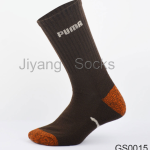Marathon runners have been sporting compression socks for several years. Knee-high socks, however, don’t occur naturally on trails, and have been known to scare away small
animals and potential mates.
Maybe that’s why trail runners have been a little slower to adopt the look. Now compression
technology is hitting the roads and the dirt as compression calf sleeves were all the rage at this
year’s Gore-Tex TransRockies Run.
Team Salomon not only raced in the stylish black-and-silver-patterned sleeves, but relaxed and recovered in them, too. A few other runners sported the
colorful Zensah sleeves.
The makers of the expensive products tout the performance benefits of compression technology,
but in terms of science, compression calf sleeves are kind of like ice baths. The people who use
them swear by them. The people who study their effectiveness? Not so much.
If you’re not quite ready to shell out the average $40 to $60 cost for calf sleeves, I’ve come up
with a few other justifications to rationalize the purchase that don’t depend on science.
Protection: They protect your legs from small scratches, abrasions and nasty things like poison
ivy on the trail.
Swelling: Compression technology has been proven to limit swelling, especially in people who
spend all day on their feet. I’m guessing spending 24 hours on the trail for a 100-mile ultra counts.
Dirt: Collects on your sleeves and not on your legs.
Warmth: Allows you to wear shorts on those iffy days when you’d reluctantly wear tights.
Coolness: No they don’t keep you cool, but the Team Salomon guys looked pretty darn cool in
their Salomon EXO III calf sleeves.
A couple of tips before you make a purchase: Don’t buy white. Also, make sure you measure
your calves for proper sizing. Too tight and they’re uncomfortable and impossible to put on.
Too loose and they don’t provide enough compression and slide down on the trail.




